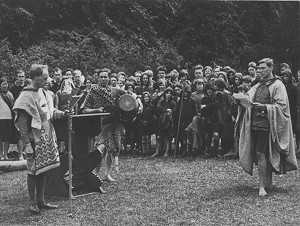Kibbo Kift

The Kindred of the Kibbo Kift was a youth organisation in England from 1920 to 1951.
Origins
The organisation was founded by the charismatic Englishman John Hargrave (aka 'White Fox'), artist, author and Boy Scout Commissioner for Woodcraft and Camping, who had become disenchanted with the increasingly militaristic tendency in the Scout movement after World War I.
Hargrave was promptly expelled from the Scouts by Scout founder Robert Baden-Powell. With a small group of like-minded, dissident, anti-war Scoutmasters and Scoutmistresses under his own direct leadership, he set about building an alternative and very different movement. Baden-Powell expelled Hargrave with extreme reluctance, and only after some wealthy backers had threatened to withdraw funding from the Scouts unless he was expelled.[1]
The Kibbo Kift (archaic Kentish dialect for 'proof of great strength'[2]) has been described as 'the only genuine English national movement of modern times'[3] and was certainly very different from Baden-Powell's Boy Scouts.[4]
Based on the woodcraft principles of naturalist Ernest Thompson Seton that had been a key part of the early Scout programme, the Kibbo Kift was to be not merely a youth organisation but was to involve all ages and, very daring for the times, it was open to both sexes. The ideas of world peace and the regeneration of urban man through the open-air life replaced the nationalism and militarism Hargrave had detested in the post-World War I Scouts.
Activities
Kinsmen and women were organised in Clans, Tribes and Lodges. Each individual took a 'woodcraft name', inspired by their ideas of 'Indian-style' names. The correct costume had to be hand-made by each individual or 'rooftree' (family group) and while the everyday 'habit' of Saxon hood, jerkin, shorts and long cloak must have seemed outlandish enough in the English countryside of the early 1920s; for ceremonial occasions, brilliantly coloured surcoats or silk-embroidered robes were worn by the various office-holders such as the Tallykeeper, Campswarden, Ritesmaster and Gleeman. Hargrave himself was 'Head Man' and his leadership was dynamic, inspirational and frankly autocratic.

The Kibbo Kift's central activities of hiking and camping were refined and elevated to the level of a spiritual exercise. The weekend 'Tribal' Camps and the great annual 'Althing' were marked by colourful and impressive ritual, inspired by their ideas of what Native American ceremonies might be like, but couched in language reminiscent of the Norse Sagas and rich in Saxon archaisms. Kinsmen were not only required to make their own lightweight, one-man hiking tents (the first seen in England) but to decorate them with vivid, symbolic designs of their own devising. Influenced by Hargrave's own artistic taste, an ultra-modern 'futurist' style of design became general, and the robes, regalia, tents and other items of decorative art, often of an extremely high standard, represent an extraordinary 'democratisation' of the avant-garde art of the day.
The Kibbo Kift were never more than a few hundred strong. Kinsmen and Kinswomen included the Suffragettes Emmeline Pethick Lawrence, Mary Neal and May Billinghurst, the journalist Henry Nevinson, the photographer Angus McBean, and Ruth Clark. The Advisory Committee included Havelock Ellis, Maurice Maeterlinck, the Bengali poet Rabindranath Tagore, H. G. Wells and Professor Julian Huxley. D. H. Lawrence took an interest in the Kindred and it has been suggested that Mellors in Lady Chatterley's Lover is based on an archetypal Kinsman.[5]
The growth of the Kibbo Kift was not without its setbacks. In 1924, the South London co-operative lodges challenged Hargrave's leadership, and seceded from the movement. They established their own organisation, The Woodcraft Folk, which outlived its parent organisation and still exists as of 2013. This was largely the result of the attempt by Ramsay Macdonald's Labour Party to compel the Kibbo Kift to become their youth wing. When Hargrave refused, a Labour Party member, Leslie Paul, led the breakaway movement.[6]
As early as 1922, Hargrave had become interested in the ideas of Social Credit. These were first put forward as early as the First World War in The New Age magazine which, under the radical leadership of A R Orage, enjoyed an influence out of proportion to its circulation.[7] In the second half of the 1920s, Hargrave became progressively more preoccupied with the works of C.H. Douglas and his radical economic theory of Social Credit. In 1931, the Kibbo Kift transformed itself into a propaganda machine of a politico-economic movement and activity was now to be centred on the industrial cities. Again, the movement was split from top to bottom, but by 1932, the transformation was complete. The Anglo-Saxon costume, camping, hiking and woodcraft were replaced by military uniform, marching and propagandising. The name was changed to the 'Green Shirt Movement for Social Credit', and later to the Social Credit Party of Great Britain.
However, other historical forces were at work. The Public Order Act 1936, that banned the wearing of uniforms by political groups, was a great setback for a movement that relied on agit-prop, but it was World War II that provided the deathblow. The organisation was wound up in 1951.
See also
References
- ↑ Hargrave, in an interview with the historian James Webb. James Webb, The Occult Establishment, Richard Drew, 1981.
- ↑ Andrew Marr, The Making of Modern Britain, Macmillan, 2009.
- ↑ Professor L.P. Elwell-Smith, Introduction to John Hargrave, The Confession of the Kibbo Kift, London, 1927; facsimile 1979.
- ↑ Andrew Marr, The Making of Modern Britain, Macmillan, 2009.
- ↑ Armstrong, Tim (2005). Modernism. Polity Press. p. 83. ISBN 0745629830.
- ↑ Webb, The Occult Establishment
- ↑ Wallace Martin, The 'New Age' under Orage, Manchester University, 1967.